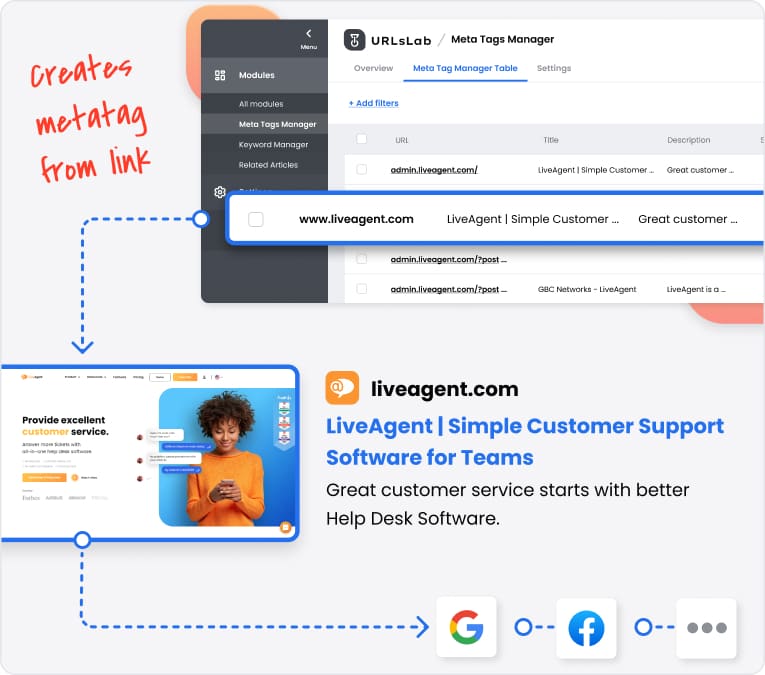Meta Description
A meta description is an HTML element that summarizes a webpage’s content, influencing user clicks and indirectly boosting SEO and engagement.
What is meta description?
The meta description is an HTML element that provides a brief summary of the web content. This summary shows up in search engine results pages (SERPs), underneath the page title and URL. The main function of this metadata is to give users a glimpse of what they can expect from clicking on the link.
This tiny piece of meta-data offers the opportunity to persuade prospective visitors that the content on the page is relevant to their query. From an SEO perspective, this is immensely valuable as it could be the deciding factor between a click-through to the webpage or a missed opportunity.
Why are meta descriptions important?
Meta descriptions act as organic ad copy, convincing users to visit your site. They can highly influence a user’s decision to click on your result versus a competitor’s.
The importance of the meta description lies in its ability to indirectly boost SEO. When your meta description is engaging and relevant to the query, more users are likely to click on your link. These additional clicks signal to search engines that your content is valuable, thus potentially improving your overall ranking.
Also, meta descriptions are essential for social sharing. When your link is shared on social platforms like Facebook or LinkedIn, the meta description is typically pulled in as the description of the link. Therefore, a concise and compelling meta description can drive social media engagement and increase your web traffic.
Types of meta descriptions
Meta descriptions can be either manual or auto-generated. Manual meta descriptions are handcrafted by the page’s author or SEO. These are typically more compelling as they can be customized to capture the essence of the page content.
Auto-generated meta descriptions, on the other hand, are created by algorithms that pull from the page’s content. Search engines like Google often create their meta descriptions if the existing one lacks relevance or when a meta description isn’t present.
Despite the difference, both types serve the same purpose: to present users with a concise and appealing synopsis of the webpage content.
Examples of meta descriptions
Product pages
An e-commerce website can use meta descriptions to highlight the key features of a product. This can lead potential customers to click and purchase the item.
Blog posts
For blog posts, meta descriptions can encapsulate the main takeaways or exciting facts from the post — enticing readers who are hunting for such information.
Landing pages
Landing pages, especially for digital marketing campaigns, need compelling meta descriptions. They can tease the offer or value the user will receive — promoting higher click-through and conversion rates.
Handy tips about meta descriptions
Optimizing meta descriptions requires a blend of creativity and keen SEO awareness. Here are some practical tips for creating effective meta descriptions:
Include your primary keyword
Including your primary keyword in the meta description will not directly influence your web-page ranking, but it indicates to readers that your content is relevant to their query.
Write actionable content
Make sure your meta description compels users to click your link. Use a strong call to action and highlight the value they’ll get from visiting your page.
Limited character count
Limit your meta description to around 155 characters as search engines typically cut descriptions that are too long.
Conclusion
Meta descriptions, in their essence, serve as the storefront window to your webpage’s content. They give users a glimpse into what they can expect, nudging them to choose your link over others.
While they don’t directly influence SEO, they play a monumental role in driving organic traffic and improving click-through rates. Hence, every single webpage, regardless of its type or purpose, must have a well-crafted and compelling meta description.
Frequently asked questions
- Do meta descriptions impact SEO directly?
No, meta descriptions don’t directly impact a webpage’s ranking on search engines. However, they do indirectly influence SEO by improving click-through rates.
- What is the ideal length for a meta description?
The ideal meta description length is around 155 characters. This ensures that your meta description isn’t truncated on search engine results pages.
- Should every webpage have a meta description?
Yes, every webpage should have a unique meta description to increase click-through rates and provide relevant summaries for users.
Optimize Your Meta Descriptions for Better SEO
Enhance your website’s visibility and engagement with well-crafted meta descriptions. Explore tools and plugins to simplify the process.


